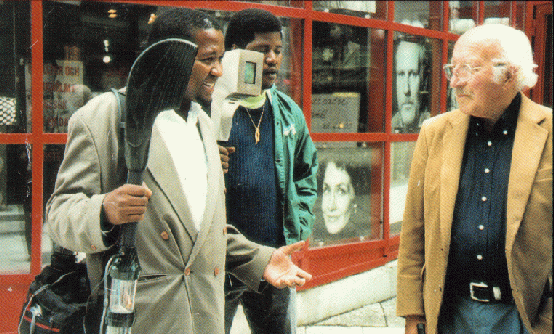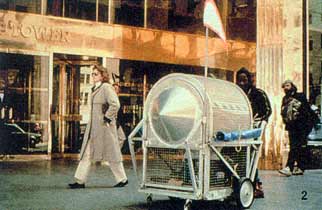Krzysztof Wodiczko is an artist whose most famous work are his slide and video projections on architectural buildings and monuments. He was born April 16, 1643, in Warsaw, Poland and was the son of Bohdan Wodiczko who was a Polish orchestra conductor. Wodiczko was born during the Warsaw Ghetto Uprising. He grew up in the post war of WWII. He went to school at the Academy of fine arts in Warsaw and graduated their in 1968 with an M.F.A. in industrial design. For the next two years his job was designing electronic products for UNITRA. After that he worked for the Polish Optical Works for seven years. In 1977 he emigrated to canada.
Some of Wodiczko's first works were expertly designed and made, but had no function. They were a response to modern technology in an ironic way. In 1969 he colaborated with Andrzej Dluzniewski and Wojchiech Wybieralski. They were to design a proposal for a memorial to the victems of a concentration camp in poland called Majdanek. In the same year he performed in the streets with another of his works called the Personal Instrument. Also in 1971 he was the leader of a group architectural movement in the Biennale de Paris
. He taught in the Acadamy of Fine Arts from 1969 to 1970 and then at the Warsaw Polytechnic Institute until 1976. In 1971 he started on the Vehicle, a machine made of wood and bycycle wheels that was set into motion by unproductive means. He created his first solo instilation in 1972 in Corridor at Galeria Wspolczesna, Warsaw and exhibited in Galeria Foksal, Warsaw in 1975. In 1974 he experimented with the relationship between real objects and visual perception. He did this by projecting a drawing of a stool on a wall which produced a 3d illusion. 1975 Wodiczko traveled to America and worked at the University of Illinois, Urbana as the artist-in-residence and also exhibited at the N.A.M.E. gallery Chicago. In America he started his work with slide projection. His projections, which were large-scale projections on public buildings, were ironic to the architectural structure it was shown on. Wodiczko started an artist-in-residence program in 1976 at the Nova Scotia College of Art and Design in Halifax, Canada. In 1977 he emigrated to Canada and started teaching at the university of Guelph in Ontario and also started working with Hal Bromm. He taught at Ontario College of art in Toronto in 1979. He was artist in residence at the South Australian School of Art from 1981 to 1982. In 1983 Wodiczko moved to New York City nd taught at the New York Institue of Technology. From 1987 to 1988 he worked with a group of homeless in New York to make the Homeless Vehicle. It was made not only for the transportation of homeless but also to draw attention to the problem of homelessness.




